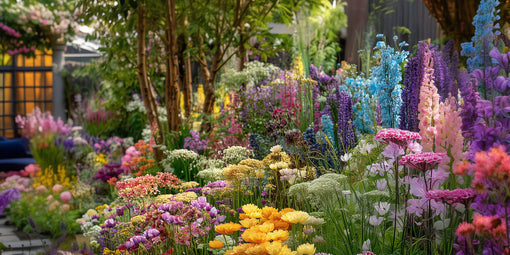
- Article published at:
Drawer menu

Lisianthus is a delicate perennial flower that’s often favoured by floral designers and florists when creating flower arrangements and bouquets. It’s a versatile bloom and brings a classy and elegant feel to most bouquets.
In this post we’ll list the most important things you need to know about lisianthus including how to grow your own.

The lisianthus originates from North America where you can find it growing in desert riverbeds and in prairie regions. In Texas, Nebraska, Nevada and Colorado they call this plant the prairie gentian.
The modern day lisianthus was in fact created in Japan by flower breeders in the 1930s. They developed and crossbred the prairie gentian into the cut flower that we know and adore today.
The lisianthus flower symbolise gratitude and appreciation which makes it a perfect addition in a thank-you bouquet.
As we mentioned the lisianthus flower is very versatile. It comes in a range of colours such as white, blue, purple, lavender, pink, yellow, as well as bicolour combinations of those hues.
Apart from its colour, the lisianthus flower also comes in different shapes. For example single form, where the flower simply have one ring of petals around the center, or a double form with several rows of petals.

The first thing to think about when deciding to grow lisianthus is to plan ahead and invest some time. This plant can take a long time to grow from seed, sometimes as long as up to 20 months. The seed of this plant is also so fine and dust-like that it can be difficult to sow just a few plants at a time.
Lisianthus plants needs full sun, so pic a spot where the plant can get at least six to eight hours of sunlight a day. If you live in a very hot area, the plants will benefit from some afternoon shade, if possible. The important thing is that the lisianthus gets consistent sunlight.
Choose a planting site with well-drained soil. Containers or raised beds are ideal. The richer the soil is the better, the lisianthus loves soil that is rich in organic matter. The soil should however be well-draining, to avoid the roots from rotting.
Water the plants frequently but do not overwater and never allow them to remain soggy. Overwatering your plant can encourage fungal diseases to develop.
Lisianthus flowers need a constant stream of nutrients to be able to produce well-branched plants with lots of blooms. Feed your plant at least once per month with a fertiliser that has one and a half times the amount of potassium as nitrogen.

We’ve already mentioned the vast variety of the lisianthus flower and there are also many different cultivars of lisianthus, distinguished by their colour and size.
This variety is full of blooms, with dozen flowers per plant all in shades of blue.
Most florists prefer using double-flower lisianthus in our arrangements, but this type of lisianthus is very tolerant to the heat which can be helpful in wedding arrangements during the summer months.
This is a tall lisianthus variety that can grow up to 34 inches tall and has dark blue flowers that blooms from midsummer right up to winter.
This is a more compact and shorter type of lisianthus, about 5 to 6 inches tall. It is bicolour, usually white with pink edges.
The maurine lisianthus is a semi-dwarf variety that’s heat tolerant which makes it a perfect plant to grow in pots on your terrace and patio.
Looking for a flower delivery with Lisianthus? Our letterbox flowers can be delivered with Same Day Delivery within London or Next Day UK wide.
Comments 1
What a beautifully informative post on Lisianthus! 🌸 I’ve always admired these delicate flowers, but I had no idea they carried such rich symbolism and fascinating history. The fact that they symbolize appreciation, gratitude, and charisma makes them even more special in bouquets and gardens alike. And those fun facts—like how they can be mistaken for roses due to their stunning blooms—just add to their charm!
By the way, I’ve found similar high-quality content on www.urbangardenguides.com, which I highly recommend checking out for more gardening tips and floral insights. Thanks for sharing such valuable information! 🌿